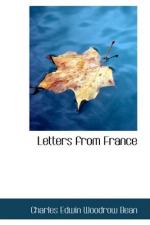In the turmoil which covered that corner we scarcely noticed that the nature of the shelling had suddenly changed. Our shell-bursts had gone much farther up the hill—one realised that; and heavy black clouds were spurting into the air below Boiselle, just behind the hill’s shoulder. The crash, crash, crash, crash of four heavy shells, one following another almost as quickly as you would read the words, focused all one’s attention on that point. The fire on it was growing. The Germans were shooting down a valley, almost a funnel, invisible to us. But we could see that the fire was increasing every minute; 4.2’s were joining in, and field guns; the lighter guns firing shrapnel, the heavier guns high explosive. The black smoke of German high explosive streamed up the valley like a thundercloud. La Boiselle was entirely hidden by it.
There could be no doubt now where our infantry was to attack. That cauldron was the barrier of shell fire which the German artillery was throwing in front of them.
It seemed no living thing could face it. Our fire had lengthened at about 4 o’clock. The German barrage began almost immediately after. Minute after minute passed without a sign of any troops of ours. Our spirits fell. “It is one of these fearful attacks on small objectives,” one thought, “where the enemy knows exactly where you must come out, and is able to converge an impenetrable artillery fire on that one small point. If you attack on a wide front, your artillery is bound to leave some of the enemy’s machine-guns unharmed. And when you have to mop up the small points that are left, and attack on a small front, he gets you with his artillery—you get it one way or the other.” One took it for granted that the head of this attack had been turned.
Suddenly, out of the mist, came the sound of a few rifle shots. Then bursts of a machine-gun. It could only be the Germans firing on advancing British infantry.
And presently they came out, running just beyond the shoulder of that hill. We could only see their heads at first, tucked down into it as a man bends when he hurries into a hailstorm. Presently the track on which they were advancing—I don’t know whether it was originally a road or a trench, but it is a sort of chalky sandhill now[2]—brought them for a moment rather to our side of the hill into partial shelter. Each section that reached the place crouched down there for a moment. Spurts of shrapnel lashed past them whirling the white dust. Black rolling clouds sprang into existence on the earth beside them. Every minute one expected to see one of them obliterate the whole party. But, at the end of a minute or so, someone would pick himself up and run on—and the remainder would follow.
[2] What we thought was a road or sandhill I afterwards found to be the upturned edge of one of the two giant mine craters, south of La Boiselle.
Not all of them. Some there were who did not stir with the rest. Other figures came running up, heads down into it, often standing out black against white bursts of chalk dust. I saw one gallant fellow racing up quite alone, never stopping, running as a man runs a flat race. But there were an increasing number who never moved. And, though we watched them for an hour, they were still there motionless at the end of it.




